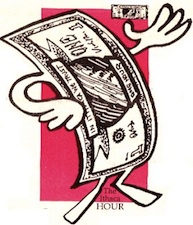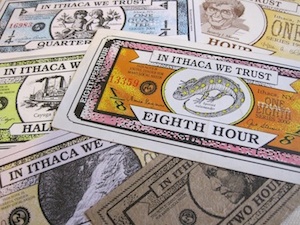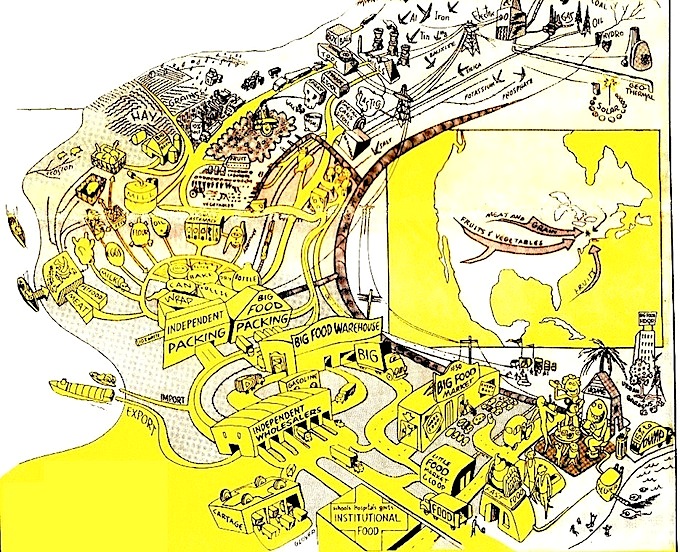now
import about 85 percent from an average of 1,300 miles away.
Ithaca's grand orchards, gardens, wheat-, oat- and corn fields lost
ground to Great Plains' harvests, to federal farm policy, and to the
region's latest crop: suburbs. Some 540 farms are left here on 34
percent of land area; 10 to 20 cease each year.
As the cartoon
shows, metals and fuels forge tools which raise food. The food we buy
has survived bugs, birds, weeds, diseases, erosion, drought, flood,
poison, harvest, storage, trimming, crushing, mixing, cooking,
packaging, spoilage, more storage, and transport to wholesalers and
then markets, to be swallowed by us.
The system never rests,
delivering the greatest variety of eats for the least paycheck, any
place on earth. From high above, our machines and trucks and toilers
would look like blood cells racing through an athlete. We are fed so
well we can live preoccupied with careers, romance, God, homes, sex,
families and thrills.
But there are problems in heaven. Ithaca
has become an army camped far from its sources of supply, using distant
natural resources faster than these renew. Every day 4,000 additional
U.S. residents each require as much food as you, yet nationwide each
day agricultural land twice our City's area is destroyed for suburbs,
shopping centers and stripmines. Within ten years California's crops
will feed only Californians, says that state's agricultural
commissioner
-- not Ithacans. Mexicans will also become starved enough to push ahead
of us in line for the food they grow. Meanwhile, the Prairie
Breadbasket faces groundwater shortages and loss of irrigated cropland.
Florida's orchards are being ripped out for suburbs.
And worse:
Costlier fertilizers and deadlier pesticides are needed to pump more
food from overworked dirt. Millions of cubic yards of topsoil fly or
float away daily. At the same time, America sells grains abroad, trying
to feed nations which have preceded us toward agricultal ruin. More
hunger is served by less land every day.
The Good News
Relax,
though, don't eat faster. We are not riding a spoon to the mouth of
doom. There are many organizations working to grow healthy food
systems. The Natural Organic Farmer's Association (NOFA) seeks to
certify New York's authentic uncontaminated produce. Hometown food is
fresher, too, andmore nourishing.
Local food production also
enriches Ithaca by keeping money here that would otherwise go to Big
Food headquarters far away. The $500,000 spent yearly for food at the
Ithaca Farmer's Market bounces around Upstate longer, creating more
jobs. Moreover, it's an investment in Ithaca's agricultural future.
Likewise,
most of GreenStar Co-op's summer vegetables are supplied by nearby
farmers or wholesalers, like Finger Lakes Organics, Richview Farms, or
Ludgate's. Several restaurants and other grocers try to do so also. In
fact, the Finger Lakes Food Association will provide retailers with
lists of fresh local supplies. They celebrate regional harvests during
Finger
Lakes Food Week.
The
most direct marketers of all is Project Growing Hope, the community
gardens off Meadow Street. Since 1976 they've provided land for as many
as 250 landless yearly.
How well could New York live from its
own back yard? Michael Turback, former owner of the Made in New York
Store and Turback's restaurant, proudly notes our state is already #2
nationally in production of wine ("some of it world class") and cheese
("Cuba, New York's is the best cheddar I've eaten") and apples. This
county has in the past produced huge quantities of nearly every staple
sold in markets today. Among the 171,000 apple trees counted here in
1885 were varieties flavored like strawberries and bananas, some mild
and others almost too sweet to binte. Many regionas perfected
distinctive local crops. Once you could taste Ithaca.
Cooperative
Extension of Tompkins County publishes a "Guide to Local Food
Producers." The Farming Alternatives Project assists Extension by
|
providing
information about organic agriculture, or unusual crops, like
aquaculture.
Though Cornell has mainly served agribusiness,
there are campus organizations which research and promote sustainable
agriculture, the kind that feeds the soil feeding us. the Farming
Alternatives Program helps agribusiness and small farmers make
practical transitions to healthy cultivation. The Ecological
Agriculture Research Collective refined organic farming techniques and
maintains a showcase garden. Sustainable Cropping Systems
Design has
been taught: building gourmet soils, the food of food. Perhaps Cornell
biotechnicians will invent tropical edibles that love snow:
pineapplecicles, rice cubes and lemonades.
Tompkins County's
Soil Conservation Service (USDA) works with farmers to slow erosion.
"Forest fires are more dramatic, but not more destructive," says Gary
Lamont.
There are other encouraging signs. Many citizens do their part to help
by one or more of these changes:
* We eat less meat, so that grains are fed to humans, and animals do
not
suffer.
* We shop for New York labels, rather than eating food hauled
cross-country.
* We grow some of our own food.
* We recycle kitchen scraps into our gardens.
* We buy bulk when we can, looking for food value rather than packaging.
* We ask our grocer to stock organic fruits and vegetables.
* We support small farms by spending at farmer's markets.
* We plant fruit trees rather than ornamentals.
* We control retail sales by joining or starting a buying club or co-op.
* We have a good time without wasting metals, plastic, oil, paper and
electricity.
*We have one or fewer children, and adopt the rest.
Even
large factory farms are beginning to learn the benefits of non-toxic
pest control, drip irrigation, green manure, mulching, intercropping,
rotation and genetic diversity.
Cities and towns are starting to
analyse urban agricultural potential, to plant edible parks, to link
building codes and development options to urban agriculture, to fund
food preservation centers, turn clean sludge into fertilizer, establish
agricultural zones, and give tax breaks to greenhouses.
The
State of Pennsylvania buys the farming rights to agricultural land
threatened with suburbanization. These and related things can be done
here at the insistence of citizens. In fact, it has been suggested that
Ithacans buy Ithaca by selling raffle tickets to create a greenbelt.
Some Ellis Hollow residents have already pooled money to keep their
forests green.
The time is ripe. Recently our city converted its last farm into a
shopping mall. And the Town of Ithaca sees leapfrog growth.
Securing
an American Future
Changes
in food and fuel suply and dirstribution will bring changes in our
personal lives, corporate goals and legal contracts. Some changes will
be easy, others hard. All are opportunities for living better. Sooner,
rather than later, developers will lose the right to destroy topsoil
that could feed thousands of Americans for hundreds of years, merely to
house suburbanites. But their skills will be needed to rebuild Ithaca
toward balance with nature. These new laws, organizations and personal
styles show understanding that, no matter how super our computers, we
will never invent substitutes for food, water and air, that our nation
will progress or erode with its soil, that ultimately the land is the
law of the land.
Originally
published in the Grapevine
Weekly
February 18, 1987. |


